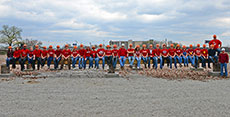Solar Decathlon 2013
Kentucky/Indiana: University of Louisville, Ball State University, and University of Kentucky
For the U.S. Department of Energy Solar Decathlon 2013, University of Louisville, Ball State University, and University of Kentucky designed the Phoenix House, which helps families rebuild resilient communities in the wake of a natural disaster. The house can be assembled rapidly using a prefabricated main living core and a secondary bedroom module. The house uses durable, low-maintenance, reclaimed materials and an open floor plan with a vaulted ceiling to maximize space. Designed to be self-sustaining, the Phoenix House produces all its energy from photovoltaic panels and recycles much of its own water.
Design Philosophy
The Phoenix House is a permanent solution for disaster relief housing and is designed to be quickly deployed and assembled while preserving a high standard of living. Using reclaimed materials throughout, the Phoenix House incorporates elements of an old house into a new one. It combines traditional and contemporary aesthetics in the interior and exterior and supports green living by enabling families to be less reliant on nonrenewable sources of energy.
Features
- Exterior cladding made of a fiber cement panel rain screen and reclaimed wood siding is built for high durability and low maintenance.
- The multipurpose living room transforms into an entertainment space, home office, or extra bedroom and extends to a large deck.
- An open floor plan with vaulted ceilings and a loft maximizes space and storage.
- The bathroom doubles as a weather shelter with a steel door, multiple layers of envelope materials, and a non-shattering window.
- The master bedroom features French doors that open to a private patio enclosed by a grapevine-covered green wall.
- A natural kitchen garden provides fresh herbs and vegetables.
Technologies
- Structural insulated panels in the walls and roof systems enable increased efficiency, ease of construction, and improved structural resistance.
- The sloped roof houses 7.6 kW of solar panels to power the house.
- An energy-recovery ventilator constantly exchanges air to provide high air quality.
- A solar water heating system integrated with the HVAC system increases the overall energy efficiency by sharing energy between the house systems through hot and cold air recovery.
- A motion-controlled, light-emitting diode lighting system maximizes energy efficiency.
- A unique wall system enables electrical and data cabling to be quickly installed with connections made behind a removable baseboard.
Market Strategy
The Phoenix house is designed for middle-class families affected by tornados or other natural disasters. Although designed to be built quickly, it is also designed to be durable, safe, and sustainable—reflecting a spirit of permanence and resilience. For its owners, the ultra-efficient house is designed for long-term comfort and cost savings.
What's Next
After the Solar Decathlon, the Phoenix House will travel to the University of Louisville, where it will serve as the administrative offices of the Conn Center for Renewable Energy Research for two to three years. In addition, the house will be used for educational, research, and outreach activities, including:
- The Conn Center will collect and monitor data on energy use and conduct energy-related research using the house as a test bed.
- Engineering classes will use the house as a teaching tool for solar power generation, energy-efficient design, and home automation and control systems.
- Public tours will be offered to industry and students. The Conn Center will organize tours for high school and undergraduate students and open house events throughout the year for faculty and students. The Conn Center will also host faculty discussions on energy and sustainability research topics.
Contact
Mahendra Sunkara, Ph.D
Phone: 502-852-8574
 Enlarge image
Enlarge image
The University of Nevada Las Vegas Solar Decathlon 2013 team (courtesy of the University of Nevada Las Vegas Solar Decathlon 2013 team).
The University of Nevada Las Vegas audiovisual presentation.
Team Deliverables
Neither the United States, nor the Department of Energy, nor the Alliance for Sustainable Energy LLC, nor any of their contractors, subcontractors, or their employees make any warranty, express or implied, or assume any legal liability or responsibility for the accuracy, completeness, or usefulness for any purpose of any technical resources or data attached or otherwise presented here as reference material.



